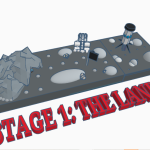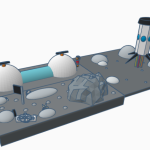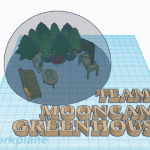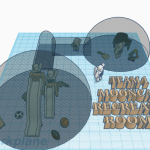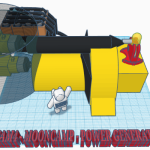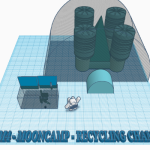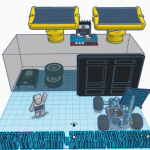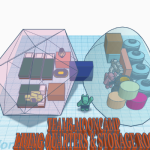Biotop auf dem Mars by Angelina und David auf dem Weg zum Mars
Schiller Gymnasium Pforzheim Pforzheim-Baden-Württemberg Germany 14 years old, 15 years old 2 / 1 German Mercury
Project description
Wir hatten die Idee,eine stationäre Raumstation, die mit dem Merkur Kreist und ein stationäres Biotop auf dem Merkur,zu modellieren.
Deshalb haben wir uns erst mit dem Merkur beschäftigt und dannach in Blender ein Model modelliert.
Unsere Ziel war es, eine Möglichkeit zu finden auf dem Merkur zu überleben und Forschungen durchzuführen.
Unsere Raumstation:
Sie ist stationär am Rande der Schattenseite(genug Licht für die Solarzellen) in der nähe der Polen (um dort Wasser in Form von Wassereis zu holen).Sie kreist mit dem Merkur um die hohen Temperaturen zu umgehen.
Unser Biotop:
Ein künstliches Biotop, welches auf dem Merkur gebaut wird und Wasser durch Wassereis bekommt, Sauerstoff durch eine Filteranlage die denn Sauertoff und andere nützliche Stoffe aus der Atmosphäre des Merkurs filtert. In dem Biotop werden Pflanzen und Tiere gehalten, sowohl für die Essensversorgung als auch für die Forschung.
Protokoll Mooncamp Reise auf den Merkur
Merkur:
Durchmesser 4.880 Kilometer Tagestemperatur +430°C
Nachttemperatur -170°C
Keine Jahreszeiten aber unterschiedliche Sonneneinstrahlung
ein Merkurtag 58,646 Erdtage ein Merkurjahr ca. 88.Erdtage
Atmosphäre:
super dünn Wasserstoff 22%, Helium 6%, Sauerstoff 42%,
Natrium 29%, Kalium 0,5%
Forschung:
Es wurden organische Moleküle (einfache Kohlenstoffe und Stickstoffverbindungen) und Wassereis => gute Voraussetzung für Leben
Oberfläche:
Von Kratern überseht, besteht aus rauem, porösem,dunklem Gestein, vulkanische Eruptionen, Plattentektonik, Magma in manchen Kratern und Wassereis
Kern:
Eisen-Nickel-Kern, hoher Eisengehalt, 80 Prozent des Planeten-durchmessers, flüssig
Magnetfeld:
1Prozent der Stärke des Erdmagnetfelds
Entfernung:
75 Millionen Kilometer = Jahre mit Lichtgeschwindigkeit
5,7Minuten von der Erde zum Merkur zur Sonne
5,8 Millionen Kilometer vom Merkur zur Sonne
-Projekt Beschreibung-Raumstation und künstliche Biotop-
-Raumstation stationär in der nähe eines Poles (Krater mit Wassereis)
für 10 Personen Aufenthalt für 1 Jahr betrieb mit Solarenergie
Ziel: Möglichkeit finden dort für „immer“ zu leben
-Künstliche Biotop auf dem Merkur mit Pflanzen und Tieren, Wasserversorgung durch Wassereis und Wasserdampf, betreiben mit Solarenergie
-Lebensraum auf dem Merkur mit Essensversorgung
English translation
We had the idea of modeling a stationary space station that orbits with Mercury and a stationary biotope on Mercury.
That’s why we first looked at the Merkur and then modeled a model in Blender.
Our goal was to find a way to survive on Mercury and conduct research.
Our space station:
It is stationary on the edge of the shadow side (enough light for the solar cells) near the poles (to get water there in the form of water ice). It orbits with Mercury to avoid the high temperatures.
Our biotope:
An artificial biotope that is being built on Mercury and gets water through water ice, oxygen through a filter system that filters oxygen and other useful substances from Mercury’s atmosphere. Plants and animals are kept in the biotope, both for food supply and for research.
Protocol Mooncamp trip to Mercury
Mercury:
Diameter 4,880 kilometers Daytime temperature +430°C
Night temperature -170°C
No seasons but different levels of sunlight
One Mercury day is 58,646 Earth days. One Mercury year is approximately 88 Earth days
The atmosphere:
super thin hydrogen 22%, helium 6%, oxygen 42%,
Sodium 29%, potassium 0.5%
Research:
Organic molecules (simple carbons and nitrogen compounds) and water ice became good conditions for life
Surface:
Overlooked by craters, consists of rough, porous, dark rock, volcanic eruptions, plate tectonics, magma in some craters and water ice
Core:
Iron-nickel core, high iron content, 80 percent of the planet’s diameter, liquid
Magnetic field:
1 percent of the strength of the Earth’s magnetic field
Distance:
75 million kilometers = years at the speed of light
5.7 minutes from Earth to Mercury to the Sun
5.8 million kilometers from Mercury to the Sun
-Project Description-Space Station and Artificial Biotope-
-Space station stationary near a pole (crater with water ice)
for 10 people stay for 1 year powered by solar energy
Goal: Find the opportunity to live there “forever”.
-Artificial biotope on Mercury with plants and animals, water supply through water ice and water vapor, operated with solar energy
-Habitat on Mercury with food supply
#3D Design #3D Printing
Other Projects
Alhaurín de la Torre – Spain
Lunar base as research center













